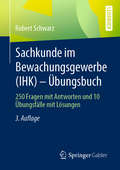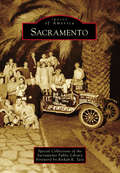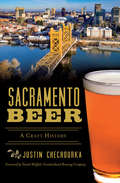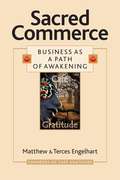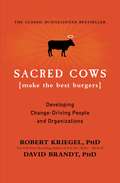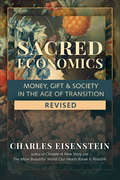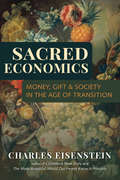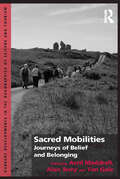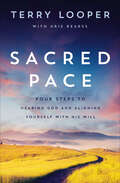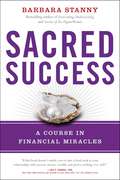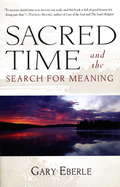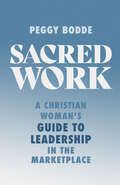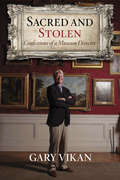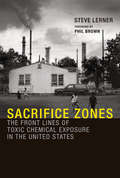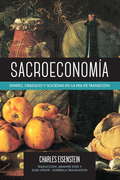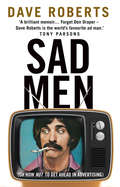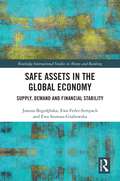- Table View
- List View
Sachkunde im Bewachungsgewerbe (IHK) - Übungsbuch: 250 Fragen mit Antworten und 10 Übungsfälle mit Lösungen
by Robert SchwarzDieses Übungsbuch ergänzt das gleichnamige Lehrbuch. Es schließt die Lücke zwischen dem Unterrichts- und Lernstoff und der Vorbereitung auf die Prüfung. Mit Hilfe der Fragen und Antworten können Lernende den wichtigen Prüfungsstoff strukturiert wiederholen, den eigenen Lernfortschritt kontrollieren und sich gründlich auf die Prüfung vorbereiten. Zehn Übungsfälle mit ausführlichen Lösungen stellen Zusammenhänge her und vertiefen das Gelernte. Die aktualisierte 3. Auflage wurde gründlich durchgesehen.
Sachkunde im Bewachungsgewerbe (IHK) - Übungsbuch: 250 Fragen mit Antworten und 10 Übungsfälle mit Lösungen
by Robert SchwarzDieses Übungsbuch ergänzt das gleichnamige Lehrbuch. Es schließt die Lücke zwischen dem Unterrichts- und Lernstoff und der Vorbereitung auf die Prüfung. Mit Hilfe der Fragen und Antworten können Lernende den wichtigen Prüfungsstoff strukturiert wiederholen, den eigenen Lernfortschritt kontrollieren und sich gründlich auf die Prüfung vorbereiten. Zehn Übungsfälle mit ausführlichen Lösungen stellen Zusammenhänge her und vertiefen das Gelernte. Die aktuelle 4. Auflage wurde sorgfältig durchgesehen.
Sachkunde im Bewachungsgewerbe (IHK) - Übungsbuch: 250 Fragen mit Antworten und 10 Übungsfälle mit Lösungen
by Robert SchwarzDieses Übungsbuch ergänzt das gleichnamige Lehrbuch. Es schließt die Lücke zwischen dem Unterrichts- und Lernstoff und der Vorbereitung auf die Prüfung. Mit Hilfe der Fragen und Antworten können Lernende den wichtigen Prüfungsstoff strukturiert wiederholen, den eigenen Lernfortschritt kontrollieren und sich gründlich auf die Prüfung vorbereiten. Zehn Übungsfälle mit ausführlichen Lösungen stellen Zusammenhänge her und vertiefen das Gelernte. Die überarbeitete 5. Auflage entspricht dem aktuellen Rahmenstoffplan vom Mai 2021.
Sachkunde im Bewachungsgewerbe (IHK): Lehrbuch für Prüfung und Praxis
by Robert SchwarzDieses Lehrbuch behandelt systematisch alle Fachgebiete der IHK-Sachkundeprüfung nach dem aktuellen Rahmenstoffplan. Besonderen Wert hat der Autor dabei auf den oft als schwierig empfundenen Rechtsteil gelegt: Zahlreiche Abbildungen und Beispiele veranschaulichen die Gesetzestexte und ihre Bedeutung für die Praxis, erleichtern das Stoffverständnis und das Lernen. Übersichtlich und verständlich erläutert das Buch die Grundprinzipien der Rechtsordnung der Bundesrepublik Deutschland und deren Anwendung, wichtige Fachbegriffe und die Stellung der privaten Sicherheit. So bietet das Werk die optimale Prüfungsvorbereitung - Schritt für Schritt. Die korrigierte und aktualisierte 4. Auflage wurde dem aktuellen Rahmenstoffplan im Frühjahr 2020 angepasst, insbesondere bezüglich der Verordnung über das Bewachungsgewerbe (BewachV).
Sachkunde im Bewachungsgewerbe (IHK): Lehrbuch für Prüfung und Praxis
by Robert SchwarzDieses Lehrbuch behandelt systematisch alle Fachgebiete der IHK-Sachkundeprüfung nach dem aktuellen Rahmenstoffplan. Besonderen Wert hat der Autor dabei auf den oft als schwierig empfundenen Rechtsteil gelegt: Zahlreiche Abbildungen und Beispiele veranschaulichen die Gesetzestexte und ihre Bedeutung für die Praxis, erleichtern das Stoffverständnis und das Lernen. Übersichtlich und verständlich erläutert das Buch die Grundprinzipien der Rechtsordnung der Bundesrepublik Deutschland und deren Anwendung, wichtige Fachbegriffe und die Stellung der privaten Sicherheit. So bietet das Werk die optimale Prüfungsvorbereitung – Schritt für Schritt. Die gründlich durchgesehene und verbesserte 5. Auflage entspricht dem aktuellen Rahmenstoffplan 2020/2021 und berücksichtigt auch die Verordnung über das Bewachungsgewerbe (BewachV).
Sachkunde im Bewachungsgewerbe (IHK): Lehrbuch für Prüfung und Praxis
by Robert SchwarzDieses Lehrbuch behandelt systematisch alle Fachgebiete der IHK-Sachkundeprüfung nach dem aktuellen Rahmenstoffplan. Besonderen Wert hat der Autor dabei auf den oft als schwierig empfundenen Rechtsteil gelegt: Zahlreiche Abbildungen und Beispiele veranschaulichen die Gesetzestexte und ihre Bedeutung für die Praxis, erleichtern das Stoffverständnis und das Lernen. Übersichtlich und verständlich erläutert das Buch die Grundprinzipien der Rechtsordnung der Bundesrepublik Deutschland und deren Anwendung, wichtige Fachbegriffe und die Stellung der privaten Sicherheit. So bietet das Werk die optimale Prüfungsvorbereitung – Schritt für Schritt. Die überarbdeitete 6. Auflage entspricht dem aktuellen Rahmenstoffplan der DIHK vom Mai 2021.
Sacramento (Images of America)
by Special Collections of the Sacramento Public LibraryGoing back to its Native American origins, Sacramento has withstood flood, fire, and plague to honestly earn the moniker Urbs Indomita or "Indomitable City." Such grit--enhanced by an unmatched embrace of diversity and the strength that comes with it--has powered the Sacramento area's role as gold rush epicenter, railroading Goliath, purveyor of hydroelectric power, world war and Cold War arsenal, agricultural hub, and policy center for one of the nation's most innovative states. Truly, the impact of the Capital City extends so much farther than the Central Valley. It is through exploring the pages within that the reader will truly understand why, as stated by Sacramento historian and developer Gregg Lukenbill, "America may have been born in Philadelphia, but the American West was born in Sacramento."
Sacramento Beer: A Craft History (American Palate)
by Justin ChechourkaHistorically speaking, Sacramento benefited from a gold rush, an agricultural boom and, more recently, a brewing renaissance. The region's craft beer scene exploded from six to more than sixty breweries in about a decade, and the roots of that culture stretch back more than a century. Before Prohibition, thousands of acres of local hops supplied brewers across the country. Local farms are once again taking advantage of the temperate climate. In 1958, the University of California-Davis started America's foremost brewing science program, producing some of California's top brewers. Rubicon's 1989 award-winning IPA was just the beginning for the current, innovative resurgence. Author Justin Chechourka explores the complexities and nuance of this fermenting heritage.
Sacred Commerce: Business as a Path of Awakening
by Terces Engelhart Megan Marie Brown Matthew EngelhartIn this timely book, authors Matthew and Terces Engelhart present the idea that love before appearances is the antidote to our spiritual, environmental, and social degradation. Exploring topics such as mission statements, manager as coach, human resources as a sacred culture, and inspirational meetings, they offer a manual for building a spiritual community at the workplace--a vital concept in an age when work consumes the bulk of most adults' time. Business, the authors explain, is all about providing a service, product, or experience the market wants, and no business can succeed by failing to understand this point. However, integrating the concept of "Sacred Commerce" into business can provide both financial success and spiritual satisfaction. Stressing that every business is an opportunity to make a lasting impact on the lives of both clients and employees, the Engelharts share the tools they've learned in their own enterprises to fulfill this vision. Sacred Commerce is the ideal mix of the personal and the practical--a guidebook written by people who have felt success, not just spent it. Dissatisfaction with work is at record levels, and the Engelharts show that you don't have to suffer personally--or give up your humanity--to pay the mortgage.From the Trade Paperback edition.
Sacred Cows Make the Best Burgers: Developing Change-ready People and Organizations
by Robert Kriegel David BrandtDemonstrates why the latest business panaceas -- re-engineering, virtual teams, outsourcing, reinventing, restructuring, downsizing -- almost always prove unsuccessful. Exposes how these buzzword programs overlook the most fundamental element of all business: people. They offer concrete strategies to help you: discover where sacred cows hide, round them up, and put them out to pasture; prepare an environment in which new ideas can grow and flourish; conquer the 4 types of resistance; motivate people to welcome change -- 5 surefire methods make it easy; cultivate the 7 personal characteristics of Change-Readiness; and perform at peak levels at all times.
Sacred Economics, Revised: Money, Gift & Society in the Age of Transition
by Charles EisensteinExpanded and updated, Charles Eisenstein's classic treatise on capitalism, currency, and the gift economy.This revised version traces the history of money, from ancient gift economies to modern capitalism, and includes new material on cryptocurrencies and emerging research that has come out since the book's original publication. CharlesEisenstein shows how capitalism contributes to alienation, competition, and scarcity; destroys community; and necessitates endless growth at the cost of social and environmental devastation. Today, these trends have reached their extreme--and their collapse presents a golden opportunity to transition to a more connected, ecological, and sustainable way of being.Eisenstein describes the deeper narratives beneath our economic system, and how we can reimagine it to align with a new story. Applying a broadly integrated synthesis of theory, policy, and practice, he explores avant-garde concepts of the New Economics, including negative-interest currencies, local economies, gift economics, cryptocurrencies, and the restoration of the commons. Tapping into a rich lineage of conventional and unconventional economic thought, Eisenstein presents a vision that is original yet commonsense, radical yet gentle, and increasingly relevant as the crises of our civilization deepen.
Sacred Economics: Money, Gift, and Society in the Age of Transition
by Charles EisensteinSacred Economics traces the history of money from ancient gift economies to modern capitalism, revealing how the money system has contributed to alienation, competition, and scarcity, destroyed community, and necessitated endless growth. Today, these trends have reached their extreme--but in the wake of their collapse, we may find great opportunity to transition to a more connected, ecological, and sustainable way of being. This book is about how the money system will have to change--and is already changing--to embody this transition. A broadly integrated synthesis of theory, policy, and practice, Sacred Economics explores avant-garde concepts of the New Economics, including negative-interest currencies, local currencies, resource-based economics, gift economies, and the restoration of the commons. Author Charles Eisenstein also considers the personal dimensions of this transition, speaking to those concerned with "right livelihood" and how to live according to their ideals in a world seemingly ruled by money. Tapping into a rich lineage of conventional and unconventional economic thought, Sacred Economics presents a vision that is original yet commonsense, radical yet gentle, and increasingly relevant as the crises of our civilization deepen.About the Imprint: EVOLVER EDITIONS promotes a new counterculture that recognizes humanity's visionary potential and takes tangible, pragmatic steps to realize it. EVOLVER EDITIONS explores the dynamics of personal, collective, and global change from a wide range of perspectives. EVOLVER EDITIONS is an imprint of North Atlantic Books and is produced in collaboration with Evolver, LLC.From the Trade Paperback edition.
Sacred Heart (How to Maintain Compassion and an Open Heart Despite the Trials of Leadership)
by Marty Linsky Ronald A. HeifetzA leader's ability to be resilient through trials, challenges, and even personal attacks will depend upon the ability to lead with an open heart. This chapter discusses the key attributes of innocence, curiosity, compassion, and how cultivating them can help stave off cynicism and callousness. This chapter was originally published as Chapter 11 of "Leadership on the Line."
Sacred Mobilities: Journeys of Belief and Belonging (Current Developments In The Geographies Of Leisure And Tourism Ser.)
by Avril Maddrell Alan TerryThis collection draws on the Mobilities approach to look afresh at notions of the sacred where they intersect with people, objects and other things on the move. Consideration of a wide range of spiritual meanings and practices also sheds light on the motivations and experiences associated with particular mobilities. Drawing on rich, situated case studies, this multi-disciplinary collection discusses what mobility in the social sciences, arts and humanities can tell us about movements and journeys prompted by religious, more broadly ’spiritual’ and 'secular-sacred' practices and priorities. Problematizing the fixity of sacred places and times as territorially and temporally bounded entities that exist in opposition to ’profane’ everyday life, this collection looks at the intersection between the embodied-emotional-spiritual experience of places, travel, belief-practices and communities. It is this geographically-informed perspective on the interleaving of religious/ spiritual/ secular notions of the sacred with the material and more-than-representational attributes of associated mobilities and related practices which constitutes this volume’s original contribution to the field.
Sacred Pace: Four Steps to Hearing God and Aligning Yourself with His Will
by Kris Bearss Terry LooperHow do we hear from God and discern His will when it&’s time to make big decisions? Terry Looper shares a four-step process for doing just that - a process he has learned and refined over thirty years as a Christian entrepreneur and founder of a multi-billion dollar company. At just thirty-six years old, Terry Looper was a successful Christian businessman who thought he had it all—until managing all he had led to a devastating burnout. Wealthy beyond his wildest dreams but miserable beyond belief, Terry experienced a radical transformation when he discovered how to align himself with God&’s will in the years following his crash and burn.Sacred Pace is a four-step process that helps Christians in all walks of life learn how toslow down their decision-making under the guidance of the Holy Spirit,sift through their surface desires and sinful patterns in order to receive clear, peace-filled answers from the Lord,gain the confident assurance that God&’s answers are His way of fulfilling the true desires he has placed in their hearts, andgrow closer to the One who loves them most and knows them best.Sacred Pace is not another example of name-it-and-claim-it materialism in disguise. Instead, it walks Christians through the sometimes-painful process of &“dying to self&” in their decisions, both big and small, so that they desire God&’s will more than their own.
Sacred Places: American Tourist Attractions in the Nineteenth Century
by John F. SearsTourism emerged as an important cultural activity in the United States in the 1820s as steamboats and canals allowed for greater mobility and the nation's writers and artists focused their attention on American scenery. From the 1820s until well after the Civil War, American artists, like Thomas Cole and Frederic Church, depicted American tourist attractions in their work, and often made their reputations on those paintings. Writers like Irving, Cooper, Hawthorne, and James described their visits to the same attractions or incorporated them into their fiction. The work of these artists and writers conferred value on the scenes represented and helped shape the vision of the tourists who visited them. This interest in scenery permeated the work of both serious and popular writers and artists, and they produced thousands of images and descriptions of America's tourist attractions for the numerous guidebooks, magazines, and other publications devoted to travel in the United States during the period.
Sacred Success: A Course in Financial Miracles
by Barbara StannySacred Success®: A Course in Financial Miracles shows women there is a better way to achieve wealth and power: on your own terms—as a woman. Barbara Stanny, the leading expert on women and money, has helped women take control of their finances for two decades—and she knows there is much more to success than how much you earn. In her work with powerful, successful women over the last 20 years, bestselling author and financial educator Stanny has found that most women's problems with money have little to do with money itself, but rather with their fear of, or ambivalence toward, power. Instead of pushing women to pursue financial success in the traditional fashion, Sacred Success seeks to redefine power from a feminine perspective. More than a financial guide, Sacred Success is a primer on power for women—a tutorial for taking charge of your life by taking charge of your finances, and not only growing your money but creating a deeper, richer, and more meaningful life. Best described as "A Course in Miracles meets the Wall Street Journal," Sacred Success gives you a proven process that uniquely blends the practical, psychological, and spiritual work of wealth. You can be financially successful without sacrificing your soul or compromising your values. You can create wealth and exercise power by staying true to your authentic self and personal mission. Start now.
Sacred Time and the Search for Meaning
by Gary EberleIn Sacred Time and the Search for Meaning, author Gary Eberle contemplates how humans' view of time has evolved throughout history, how we came to measure time, and why we feel especially starved for it now. Eberle seeks to rediscover a renewed sense of meaning in life through looking for ways to enter the realm of sacred time or "sabbath time"--where we can reconnect with the slower, deeper rhythms of life that have traditionally been experienced through worship, prayer, and the observance of holy days. Drawing from the work of Western philosophers from Aristotle to Heidegger, and on theorists from Jung to Foucault, he presents both an intellectual history of time and a personal account of his own search for sacred time. Along the way he formulates an insightful analysis of our culture's obsession with speed and efficiency, and he offers guidance for slowing down to savor life outside of schedules and routines, showing the way toward finding fulfillment in this increasingly accelerated world.
Sacred Work: A Christian Woman's Guide to Leadership in the Marketplace
by Peggy BoddeIt&’s possible for women to be strong Christians and confident leaders. There are more female professionals in the workforce than ever. But working women are also time-starved, stressed, and tired. And they often feel alone in their professional struggles.If you&’re trying to do a million things at once and feel like you&’re not doing any of them well, you&’re not alone. Mentor and longtime corporate leader Peggy Bodde views work as sacred and has invested her life in showing women how to thrive in the workplace. In Sacred Work, Peggy provides an invaluable and practical resource that answers all your leadership challenges and questions.With business and biblical savvy, you&’ll learn how to:Overcome Imposter SyndromeMake Difficult DecisionsManage Workplace ConflictPromote Yourself with ConfidenceNegotiate to WinYou&’ll also learn about what to do:When You FailWhen You and Your Boss DisagreeWhen Peers DisappointWhen You&’re Passed Over for a PromotionWhen You Need to Address Performance . . . and so much more!Women bring unique talents to the workplace, and they face specific challenges. Friend and mentor Peggy Bodde walks beside Christian women providing scriptural truth, personal examples, and practical teaching, equipping us to lead with wisdom and strength.
Sacred and Stolen
by Gary VikanSacred and Stolen is the memoir of an art museum director with the courage to reveal what goes on behind the scenes. It lays bare the messy part of museums: looted antiquities, crooked dealers, deluded collectors, duplicitous public officials, fakes, inside thefts, bribery, and failed exhibitions. These back stories, at once shocking and comical, reveal a man with a taste for adventure, an eagerness to fan the flames of excitement, and comfort with the chaos that often ensued. This is also the story of a Minnesota kid who started out as a printer’s devil in his father’s small-town newspaper and ended up as the director of a the Walters, a gem of an art museum in Baltimore. Of his quest to bring the "holy” into the museum experience, and of his struggle, along the way, to reconcile his passion for acquiring and displaying sacred works of art with his suspicion that they were stolen. Among the cast of characters are the elegant French oil heiress Dominique de Menil, the notorious Turkish smuggler, Aydin Dikmen, and his slippery Dutch dealer, Michel van Rijn, the inscrutable and implacable Patriarchs of Ethiopia and Georgia, and the charismatic President of Georgia, Eduard Shevardnadze. And the mysterious "Mr. R. Egrette,” a museum insider who in 1951 stole a tiny Renoir as a present for his girlfriend, that finally turned up and was returned 60 years later
Sacrifice Zones: The Front Lines of Toxic Chemical Exposure in the United States (The\mit Press Ser.)
by Steve LernerThe stories of residents of low-income communities across the country who took action when pollution from heavy industry contaminated their towns.Across the United States, thousands of people, most of them in low-income or minority communities, live next to heavily polluting industrial sites. Many of them reach a point at which they say “Enough is enough.” After living for years with poisoned air and water, contaminated soil, and pollution-related health problems, they start to take action—organizing, speaking up, documenting the effects of pollution on their neighborhoods.In Sacrifice Zones, Steve Lerner tells the stories of twelve communities, from Brooklyn to Pensacola, that rose up to fight the industries and military bases causing disproportionately high levels of chemical pollution. He calls these low-income neighborhoods “sacrifice zones.” And he argues that residents of these sacrifice zones, tainted with chemical pollutants, need additional regulatory protections.Sacrifice Zones goes beyond the disheartening statistics and gives us the voices of the residents themselves, offering compelling portraits of accidental activists who have become grassroots leaders in the struggle for environmental justice and details the successful tactics they have used on the fenceline with heavy industry.
Sacroeconomía
by Charles Eisenstein Susa Oñate Arianne SvedSacroeconomía analiza la historia del dinero desde las antiguas economías del obsequio hasta el capitalismo moderno, revelando hasta qué punto el sistema monetario ha contribuido a la alienación, la competencia y la escasez, ha destruido el sentimiento de comunidad y ha obligado al crecimiento ilimitado. Estas tendencias han llegado a su extremo hoy en día. Sin embargo, tras su derrumbe podríamos hallar una gran oportunidad para acometer la transición hacia un modo de ser más interconectado, ecológico y sostenible. Este libro trata de la transformación que deberá experimentar --y que ya experimenta-- el sistema monetario para encarnar dicha transición. Sacroeconomía ofrece una síntesis amplia que integra teoría, políticas y prácticas, y examina conceptos vanguardistas de la Nueva Economía, entre ellos la moneda de interés negativo, la moneda local, la economía basada en los recursos, las economías del obsequio y la restauración del procomún. El autor, Charles Eisenstein, sopesa también las dimensiones personales de esta transición, dirigiéndose a quienes aspiran a un "modo de subsistencia correcto" y a vivir en consonancia con sus ideales en un mundo aparentemente gobernado por el dinero. Recurriendo a una larga tradición de pensamiento económico convencional y no convencional, Sacroeconomía presenta una visión original a la vez que sensata, radical a la vez que moderada; una visión de creciente relevancia ante la crisis, cada vez más profunda, de nuestra civilización.
Sad Men
by Dave RobertsAll Dave Roberts ever wanted to do (apart from collect football programmes) was to work in advertising. More specifically, to work for the world's best advertising agency, Saatchi and Saatchi. There was just one problem. Even when he managed to persuade someone to employ him, Dave's copywriting assignments were mainly for second hand car dealers and double glazing companies. And Leeds, Manchester and, bizarrely, New Zealand were a long way from Charlotte Street and Madison Avenue. This was the world of the Sad Men.In his sparkling new memoir, Dave tells the story of a life shaped by his love of adverts, from seeing the PG Tips chimps at the age of three to writing infamous ads such as the Westpac Rap and having David Jason plug a family restaurant. Bursting with brilliant ideas - and some pretty daft ones - it is the cautionary tale of a quest for advertising glory... and not quite ever getting there.
Safe Assets in the Global Economy: Supply, Demand and Financial Stability (Routledge International Studies in Money and Banking)
by Ewa Feder-Sempach Joanna Bogołębska Ewa Stawasz-GrabowskaSafe assets constitute an essential component of the contemporary, international financial system and are vital to its stability. As they are perceived as risk-free assets, they are a special type of financial instrument. Although the vast majority of safe assets are issued by governments, due to the increasing interdependence of economies, resulting from the liberalisation of capital flows, financial openness and the ineffectiveness of the international monetary system, issues relating to their significance, creation and allocation are global. This book combines theoretical threads by systematising the concept and characteristics of safe assets against the background of alternative financial instruments with empirical analyses that present trends in shaping demand, supply, price conditions and various interdependencies in the financial markets. It shows the position and role of safe assets in the global financial sector, in the context of ongoing challenges, such as the evolution of forms of money and the processes of currency competition, the outbreak of financial and economic crises, the accumulation of foreign exchange reserves, financial innovations, the scale of securitisation and monetary integration. Although safe assets are not a new category of financial assets, they are inherently connected with the evolution of money. Thus, this book examines the determinants of their creation, motives of holding and the consequences of a shortage – all within the changing nature of the international financial system. Historical, political and institutional backgrounds are taken into account. This book will appeal to researchers, scholars and advanced students of macroeconomics, international finance and economics, investment analysis, financial economics and econometrics.
Safe City: From Law Enforcement to Neighborhood Watches
by Robert HesselA timely books that details the concerted effort and integration of new technology it takes to make communities safer for everyone. It&’s a basic human right to feel and be safe in your community—where you live, work, and play. But, few people know or understand everything it takes to make this possible, including making high-tech solutions available to local law enforcement and first responders. From fire departments detecting fires within seconds with thermal imaging to police departments detecting gunfire immediately through gunshot detection sensors, technology continues to evolve daily. Even surveillance cameras have taken great strides from the grainy images of years past, and just one camera can make a difference (read about how police identified the Boston Marathon bombers through a department store&’s video camera inside!). Safe City teaches the public how to harden targets and protect their homes, businesses, communities, themselves, and their loved ones. It takes a community effort to help reduce and prevent crime, and Safe City answers the questions people have along with pointing out many more that should be asked. &“As someone who is politically active, and involved with urban development, this book is like a playbook for mayors, city council, and county commissioners.&”—Topher Morrison, author of The Profitable CEO and managing director of Key Person of Influence &“Provides a fact-filled insight into community policing . . . This a good read that delivers a solid understanding of the &‘how and why&’ of the future of community policing in America.&” —Retired Deputy Chief Metro Detroit Police Department
